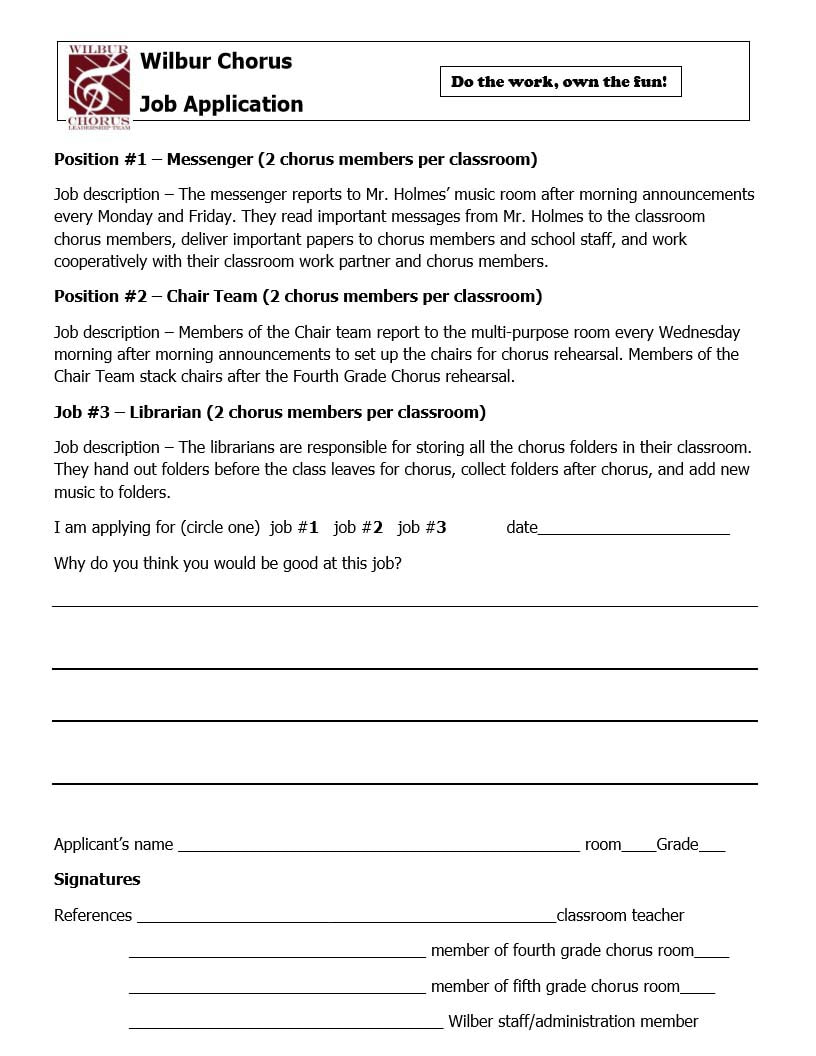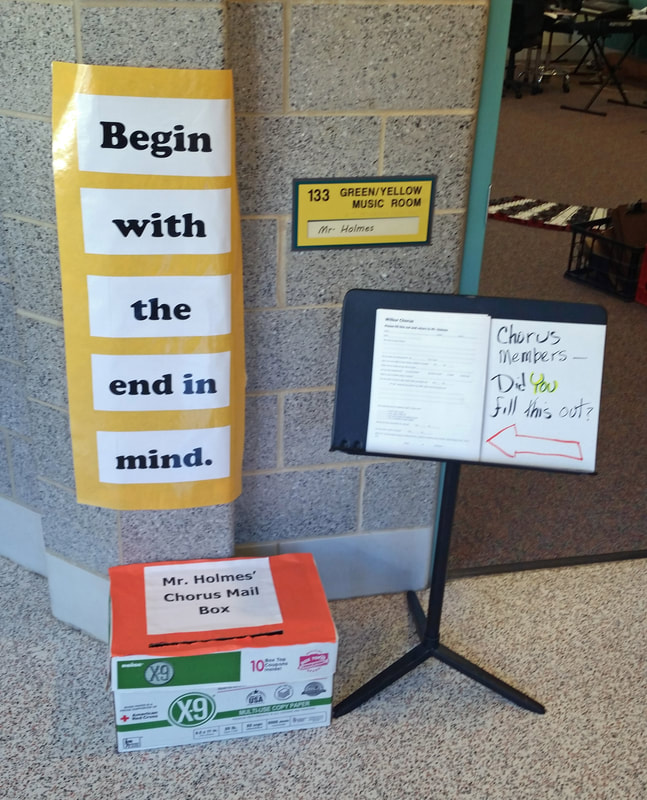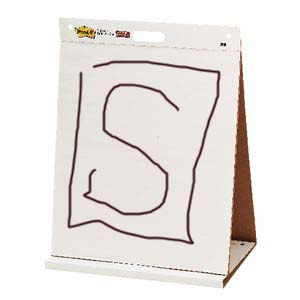I probably had the strongest chorus of my career my last two years of teaching.
The membership numbers were astronomical and constantly growing. After over twenty years in the Colonial School District, I was finally in one school five days a week. I was now teaching full-time in a school with an enrollment upwards of 2,500 students and focusing all my time and energies in one building.
My first full-time year (my second-to-last-year), I inherited a chorus of thirty-five students. By the end of the year, it had grown to over 150 students – and that was only fourth and fifth grade. My principal did not want to commit to a third grade chorus until she saw what kind of product I would produce my first year.
The chorus exceeded most of the school’s expectations – most notably, it exceeded the members’ expectations. They made an incredibly beautiful sound. At the end of that year, we made plans for a third grade chorus the following year.
Chorus rehearsals were dynamic. The chorus folders were stocked with at least a dozen different types of songs from simple pop songs and folk songs to complex three-part pieces. There was a general buzz in the school on chorus days. One of the toughest elements of the whole project was keeping a lid on their enthusiasm and dealing with the increased membership. I knew going into my second year that I would have to build a student leadership/employment component into our program.
My schedule was hellish to boot. There was no time built in for preparation, no time to get from my music room to our multi-purpose rehearsal room to run back-to-back sessions. With no wiggle room to clean up from rehearsal, deal with questions, or get back to my music room to teach, of all classes kindergarten, easily my most demanding class of the day, I needed a plan that could partly sustain itself and create logistic momentum.
There was an old line I used to say about working in schools which was if you can't have the kids working for you, what good is it?
I decided to put that joke into actual practice and develop a workforce for chorus.
I created a list of jobs with specific job responsibilities. These jobs wouldn't be given to the kids with the cutest smile or the most hyper active desire to please a teacher. Instead, I created job applications where students had to proactively pick up an application and fill out information including references. The applicants needed people to vouch for them and the job they were applying for.
Job seekers needed a signature from their classroom teacher, a current member of fourth and fifth grade chorus, as well as a staff member from the school, such as a teacher, administrator, cafeteria worker, or bus driver. The applicants also had to write why they thought they would be good at the job they were applying for.
This created a huge amount of positive buzz with kids getting hundreds of signatures from staff and chorus members. Everyone - adults and kids alike - seemed to be talking about "getting a chorus job"
The membership numbers were astronomical and constantly growing. After over twenty years in the Colonial School District, I was finally in one school five days a week. I was now teaching full-time in a school with an enrollment upwards of 2,500 students and focusing all my time and energies in one building.
My first full-time year (my second-to-last-year), I inherited a chorus of thirty-five students. By the end of the year, it had grown to over 150 students – and that was only fourth and fifth grade. My principal did not want to commit to a third grade chorus until she saw what kind of product I would produce my first year.
The chorus exceeded most of the school’s expectations – most notably, it exceeded the members’ expectations. They made an incredibly beautiful sound. At the end of that year, we made plans for a third grade chorus the following year.
Chorus rehearsals were dynamic. The chorus folders were stocked with at least a dozen different types of songs from simple pop songs and folk songs to complex three-part pieces. There was a general buzz in the school on chorus days. One of the toughest elements of the whole project was keeping a lid on their enthusiasm and dealing with the increased membership. I knew going into my second year that I would have to build a student leadership/employment component into our program.
My schedule was hellish to boot. There was no time built in for preparation, no time to get from my music room to our multi-purpose rehearsal room to run back-to-back sessions. With no wiggle room to clean up from rehearsal, deal with questions, or get back to my music room to teach, of all classes kindergarten, easily my most demanding class of the day, I needed a plan that could partly sustain itself and create logistic momentum.
There was an old line I used to say about working in schools which was if you can't have the kids working for you, what good is it?
I decided to put that joke into actual practice and develop a workforce for chorus.
I created a list of jobs with specific job responsibilities. These jobs wouldn't be given to the kids with the cutest smile or the most hyper active desire to please a teacher. Instead, I created job applications where students had to proactively pick up an application and fill out information including references. The applicants needed people to vouch for them and the job they were applying for.
Job seekers needed a signature from their classroom teacher, a current member of fourth and fifth grade chorus, as well as a staff member from the school, such as a teacher, administrator, cafeteria worker, or bus driver. The applicants also had to write why they thought they would be good at the job they were applying for.
This created a huge amount of positive buzz with kids getting hundreds of signatures from staff and chorus members. Everyone - adults and kids alike - seemed to be talking about "getting a chorus job"
I had folders tape to the wall with job applications outside of my music room.
I already had a chorus mailbox by my door so all applications had to be turned in there. Some of the jobs I had posted were:
Librarian.
It was becoming hard to keep all the music straight when we were reaching upwards of 200 people in chorus.
By the end of my last year, we had 300 chorus members. That translates into a lot of choral music parts.
Between kids being sick on chorus days when music was handed out, kids losing folders, kids in home where one night they stayed with their father and another night with their mother and chorus music was in the wrong house the night before chorus, there could be some confusion as the kids arrived for rehearsal. And then there was simply the general malaise of third, fourth, and fifth graders learning the ropes of personal responsibility and organization of materials.
Choral sheet music management was mind boggling as well as time-consuming. The librarians were responsible for getting music out to people during rehearsal if someone had lost or not received a piece of music.
When the kids came into chorus rehearsal I had the agenda already up on a huge Smart Board listing in order each of the songs we were going to practice that day. members got right to work arrangin their music in their folders. If kids didn't have the music for a specific song, they were supposed to stay in their seat, raise their hand, and a librarian would come and help them. I had three large boxes with folders containing each of the songs we were doing that year. The librarians would check on the people with raised hands, find what music needed, extract the music from the box, and hand it out.
Hall monitors.
Getting to and from course required the kids often to walk on their own through long stretches of straightaway hallways. When I say straight away, think Utah Salt Flats and the need for speed that thrives in every elemenatry school kid. Hall monitors were charged with keeping a lid on speed walkers.
Stop and Go Person.
Just as I had a one foot by one foot square on my chalkboard in my classroom with an S and a G and a magnet going back and forth visually showing I wanted stop or go time, I had a huge easel with conference paper where I had immense S and G on two sheets that could be easily flipped by a student.
Librarian.
It was becoming hard to keep all the music straight when we were reaching upwards of 200 people in chorus.
By the end of my last year, we had 300 chorus members. That translates into a lot of choral music parts.
Between kids being sick on chorus days when music was handed out, kids losing folders, kids in home where one night they stayed with their father and another night with their mother and chorus music was in the wrong house the night before chorus, there could be some confusion as the kids arrived for rehearsal. And then there was simply the general malaise of third, fourth, and fifth graders learning the ropes of personal responsibility and organization of materials.
Choral sheet music management was mind boggling as well as time-consuming. The librarians were responsible for getting music out to people during rehearsal if someone had lost or not received a piece of music.
When the kids came into chorus rehearsal I had the agenda already up on a huge Smart Board listing in order each of the songs we were going to practice that day. members got right to work arrangin their music in their folders. If kids didn't have the music for a specific song, they were supposed to stay in their seat, raise their hand, and a librarian would come and help them. I had three large boxes with folders containing each of the songs we were doing that year. The librarians would check on the people with raised hands, find what music needed, extract the music from the box, and hand it out.
Hall monitors.
Getting to and from course required the kids often to walk on their own through long stretches of straightaway hallways. When I say straight away, think Utah Salt Flats and the need for speed that thrives in every elemenatry school kid. Hall monitors were charged with keeping a lid on speed walkers.
Stop and Go Person.
Just as I had a one foot by one foot square on my chalkboard in my classroom with an S and a G and a magnet going back and forth visually showing I wanted stop or go time, I had a huge easel with conference paper where I had immense S and G on two sheets that could be easily flipped by a student.
That child sat in the front row buy me and I told them when to flip it from S to G.
Chair Detail.
Every week, I had to set up over 150 chairs first thing Wednesday morning. The chair detail member dutifully came without prompts and helped me make my endless concave rows. I couldn’t have done it without them.
Classroom Representative.
Every classroom had at least one representative who, when the “bat signal” was put out on the school intercom for chorus reps, would hustle down to my room for handouts for chorus kids in their classroom, papers that would be going home, or extra songs that I knew they would like.
Art Department.
Members of the art department were proficient in drawing and painting posters. They were given assignments to do hallway and classroom posters based on the songs we were doing in chorus or to do a poster just promoting the course. We had posters all over the school so that our entire school community could see what chorus was all about. Posters were made after lunch or during recess.
My classroom had two cheap 12 inch speakers and 4 input 100w head that I used in all of my classes. I supplemented that rig with my own mic stands, SM58 mics. I had to break all of it down, along with my electric piano and stand as well as my acoustic/electric Epiphone guitar, and get it to a multi-purpose room that was easily 3 minutes away from my classroom.
How did I manage getting all that equipment down to my rehearsal space and set up in time? The answer is in “Create a Workforce – Part Two”.
Chair Detail.
Every week, I had to set up over 150 chairs first thing Wednesday morning. The chair detail member dutifully came without prompts and helped me make my endless concave rows. I couldn’t have done it without them.
Classroom Representative.
Every classroom had at least one representative who, when the “bat signal” was put out on the school intercom for chorus reps, would hustle down to my room for handouts for chorus kids in their classroom, papers that would be going home, or extra songs that I knew they would like.
Art Department.
Members of the art department were proficient in drawing and painting posters. They were given assignments to do hallway and classroom posters based on the songs we were doing in chorus or to do a poster just promoting the course. We had posters all over the school so that our entire school community could see what chorus was all about. Posters were made after lunch or during recess.
My classroom had two cheap 12 inch speakers and 4 input 100w head that I used in all of my classes. I supplemented that rig with my own mic stands, SM58 mics. I had to break all of it down, along with my electric piano and stand as well as my acoustic/electric Epiphone guitar, and get it to a multi-purpose room that was easily 3 minutes away from my classroom.
How did I manage getting all that equipment down to my rehearsal space and set up in time? The answer is in “Create a Workforce – Part Two”.



 RSS Feed
RSS Feed